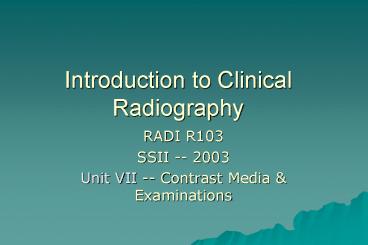Introduction to Clinical Radiography - PowerPoint PPT Presentation
1 / 20
Title:
Introduction to Clinical Radiography
Description:
difference in the transmission of x rays due to the tissues in the ... intravenous pyelogram (IVP) contrast media. iodine compound injected into bloodstream ... – PowerPoint PPT presentation
Number of Views:164
Avg rating:3.0/5.0
Title: Introduction to Clinical Radiography
1
Introduction to Clinical Radiography
- RADI R103
- SSII -- 2003
- Unit VII -- Contrast Media Examinations
2
Contrast Media
- Definitions
- "contrast"
- exhibit noticeable differences when compared
- "radiographic contrast"
- visible differences between densities on an image
- "subject contrast"
- difference in the transmission of x rays due to
the tissues in the body part
3
Subject Contrast Definitions
- radiolucent
- tissues that x rays easily penetrate
- appear dark gray to black on the image
- radiopaque
- tissues that x rays do not penetrate easily
- appear light gray to white on the image
4
Subject Contrast Chart
Very radiolucent Moderately radiolucent Intermediate Moderately radiopaque Very radiopaque
Black Dark grays Gray Light gray White (clear)
Gasses Air Fatty tissue Muscle Cartilage Blood Cholesterol stones Uric Acid Stones Bone Calcium stones Metals
5
Contrast Media"
- substance placed in the body to provide added
contrast when subject contrast is low - increases the radiographic contrast between the
area containing the CM areas not containing CM
With CM
Without CM
6
Contrast Media Properties
- able to show organ better
- physiologically inert
- no permanent alteration of organ
- non toxic
- able to be eliminated / excreted
7
Types of Contrast Media
- Negative
- allows x rays to penetrate organ more easily
- organ becomes radiolucent (darker)
- gasses
Negative CM
8
Types of Contrast Media (cont.)
- Positive
- contrast substance absorbs x rays
- organ become radiopaque (lighter)
- most common media
- barium
- iodine
Positive CM
9
Barium
- used almost solely in GI tract
- used to coat the walls of hollow organs or to
completely fill the organ - body cannot metabolize BaSO4
- contraindications
- perforations of GI tract
- proximal to an obstructed bowel
- precautions
- adequate hydration post examination
10
Iodine
- numerous brands on market but each prepared for
specific use(s) - ionic (less costly more prone to patient
reactions) - non-ionic (expensive less prone to reactions)
- major problem -- allergic reactions
- not predictable
- minor or major
- emergency preparedness
11
Iodine (cont.)
- Precautions
- right patient
- right type, dose administration
- allergic history vital signs
- Contraindications (DO NOT USE)
- hypersensitivity to iodine
- heart or renal failure
- liver disease
12
Fluoroscopic Equipment
- Perform dynamic exams
- "see action as it occurs"
- Similar to a TV in that no permanent image is
made unless additional equipment is used - Uses a fluorescent screen to project an image as
x rays pass through a part - real time viewing
13
Typical Fluoro Unit
- 1. X-ray tube under tabletop
- 2. Image viewing device above table
- projection vs. position
14
Fluoro Unit (cont.)
- conventional -- "cartoon"
- fluoro screen only
- image intensifier (II)
- screen image viewed after going through
electrical amplification - dynamic image seen on monitor
Fluorocopic unit Table in tilt position
15
Fluoro Unit (cont.)
- 3. Image recording
- static image
- "spot film" device (cassettes)
- "spot film" camera (70mm, 105 mm, etc.)
- dynamic image
- cine camera (16mm, 35mm, etc.)
- VCR from TV camera
16
Radiation Protection in Fluoro
- high exposure area
- personnel protection
- time, distance, shielding
- patient protection
- exposure timers for warning
- specialist performs fluoro
- equipment maintenance
17
Radiographer's Tasks
- Prepare room patient for exam
- Assist fluoroscopist
- contrast media administration
- patient instructions positions
- Change spot films (or other methods of recording
images) - Take scout overhead films
- Scout pre-CM radiographs
- Overhead radiographs made after CM administered
18
Exams of the GI tract
- Antegrade studies
- (with the normal flow)
- esophagus, stomach, small bowel
- contrast
- barium
- barium air
- oral iodine solution
BaSO4 Only
BaSO4 Air
19
GI Studies (cont.)
- Retrograde studies
- (against the flow)
- colon
- contrast
- barium
- barium air
BaSO4 Only
BaSO4 Air
20
Exams of the Urinary System
- Non fluoroscopic
- Antegrade studies
- intravenous pyelogram (IVP)
- contrast media
- iodine compound injected into bloodstream
- Timed set of exposures































